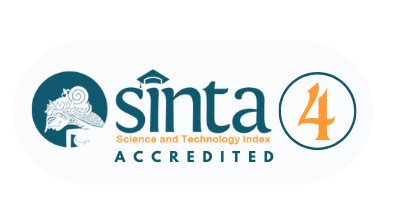Improving EFL Students’ Competencies in Writing Procedure Texts through the Process Approach
DOI:
https://doi.org/10.33633/es.v4i02.5241Keywords:
writing competencies; procedure texts; process approachAbstract
Abstract. This research aims at improving learners’ competencies in writing procedure texts through a process approach. First-year students do not demonstrate sufficient mastery of writing skills. Therefore, to overcome this matter, the investigator used classroom action research. The design of the research was action research which was composed of four phases, specifically planning the action, application, observation of the action, and reflection on the action. The subject of the research was the first-year class consisting of 29 students of MTs Al-Islam Joresan Mlarak Ponorogo. Four instruments were employed to gather the data, i.e. observation checklist, field notes, questionnaire, and students’ writing test. The finding of the research indicated that Cycle 1 has not fulfilled the criteria of success. Related to the first criterion, 70% of the learners did at minimum 64.3% of the activities (9 activities out of 14 activities) in the observation checklist, and in Cycle 2 showed 78.5% has fulfilled the criteria of success. Concerning the second criterion 65.5% (19 learners) of the learners, gained a score on a par or more than 60, the research has fulfilled the criteria of success but required rectifying. In Cycle 2, the research finding showed 95% of the learners (28 learners), the research has fulfilled the criteria of success. Concerning the final criterion, at least 82% of the learners (24 learners) served positive reactions to the application of the process approach as shown by the outcome of the questionnaire, observation checklist, field notes, and students’ writing test.Keywords: writing competencies; procedure texts; process approachAbstrak. Penelitian ini bertujuan untuk meningkatkan kompetensi siswa dalam menulis teks prosedur melalui pendekatan proses. Siswa tahun pertama tidak menunjukkan penguasaan keterampilan menulis yang cukup. Oleh karena itu, untuk mengatasi masalah tersebut, peneliti menggunakan penelitian tindakan kelas. Desain penelitian ini adalah penelitian tindakan yang terdiri dari empat tahap, yaitu perencanaan tindakan, penerapan, pengamatan tindakan, dan refleksi tindakan. Subjek penelitian ini adalah siswa kelas satu yang terdiri dari 29 siswa MTs Al-Islam Joresan Mlarak Ponorogo. Empat instrumen digunakan untuk mengumpulkan data, yaitu daftar periksa observasi, catatan lapangan, angket, dan tes menulis siswa. Hasil penelitian menunjukkan bahwa Siklus 1 belum memenuhi kriteria keberhasilan. Terkait dengan kriteria pertama, 70% peserta didik melakukan minimal 64,3% tindakan (9 kegiatan dari 14 kegiatan) dalam daftar periksa observasi, dan pada Siklus 2 menunjukkan 78,5% telah memenuhi kriteria keberhasilan. Untuk kriteria kedua 65,5% (19 peserta didik) peserta didik, memperoleh nilai setara atau lebih dari 60, penelitian telah memenuhi kriteria keberhasilan tetapi perlu diperbaiki. Pada Siklus 2, hasil penelitian menunjukkan 95% peserta didik (28 peserta didik), penelitian telah memenuhi kriteria keberhasilan. Untuk kriteria akhir, setidaknya 82% peserta didik (24 peserta didik) memberikan reaksi positif terhadap penerapan pendekatan proses seperti yang ditunjukkan oleh hasil angket.Kata kunci: kompetensi menulis; teks prosedur; pendekatan prosesReferences
Alfaki, I. M., & ?????, ?. ?. (2015). University Students’ English Writing Problems: Diagnosis and Remedy. http://dglib.nilevalley.edu.sd:8080/xmlui/handle/123456789/2116
Biber, D., Gray, B., & Poonpon, K. (2011). Should We Use Characteristics of Conversation to Measure Grammatical Complexity in L2 Writing Development? TESOL Quarterly, 45(1), 5–35. https://doi.org/10.5054/tq.2011.244483
Biggam, J. (2018). EBOOK: Succeeding with your Master’s Dissertation: A Step-by-Step Handbook: Step-by-step Handbook. McGraw-Hill Education (UK).
Duijnhouwer, H., Prins, F. J., & Stokking, K. M. (2012). Feedback providing improvement strategies and reflection on feedback use: Effects on students’ writing motivation, process, and performance. Learning and Instruction, 22(3), 171–184. https://doi.org/10.1016/j.learninstruc.2011.10.003
Hosni, S. A. (2014). Speaking Difficulties Encountered by Young EFL Learners. International Journal on Studies in English Language and Literature, 9.
Kirkpatrick, A., & Sussex, R. (Eds.). (2012). English as an International Language in Asia: Implications for Language Education (Vol. 1). Springer Netherlands. https://doi.org/10.1007/978-94-007-4578-0
Lam, R. (2010). A Peer Review Training Workshop: Coaching Students to Give and Evaluate Peer Feedback. TESL Canada Journal, 114–114. https://doi.org/10.18806/tesl.v27i2.1052
Ltd, I.-I. B. (2013). In the Importance of EFL Learners’ writing Skill: Is there any Relation between Writing Skill and Content Score of English Essay Test? International Letters of Social and Humanistic Sciences, 06, 1–12.
Mattarima, K., & Hamdan, A. R. (2011). The Teaching Constraints of English as a Foreign Language in Indonesia: The Context of School-Based Curriculum. SOSIOHUMANIKA, 4(2), Article 2. https://doi.org/10.2121/sosiohumanika.v4i2.452
Megawati, F., & Anugerahwati, M. (2012). Comic Strips: A Study on the Teaching of Writing Narrative Texts to Indonesian EFL Students. TEFLIN Journal, 23(2), 183–205. https://doi.org/10.15639/teflinjournal.v23i2/183-205
Mustafa, F., Kirana, M., & Bahri Ys, S. (2016). Errors in EFL writing by junior high students in Indonesia. International Journal of Research Studies in Language Learning, 5(5). https://doi.org/10.5861/ijrsll.2016.1366
Ouellette, G., Sénéchal, M., & Haley, A. (2013). Guiding Children’s Invented Spellings: A Gateway Into Literacy Learning. The Journal of Experimental Education, 81(2), 261–279. https://doi.org/10.1080/00220973.2012.699903
Palloff, R. M., & Pratt, K. (2013). Lessons from the Virtual Classroom: The Realities of Online Teaching. John Wiley & Sons.
Ratnaningsih, E. (2016). Improving Students’ Writing Ability through the Use of Dictogloss Technique. Transformatika: Jurnal Bahasa, Sastra, dan Pengajarannya, 12(2), 1–14. https://doi.org/10.31002/transformatika.v12i2.186
Roy-Campbell, Z. M. (2015). Teaching English as a ?ÇÿSecond Language?ÇÖ In Kenya and the United States: Convergences and Divergences. Global Education Review, 2(2). Retrieved from https://ger.mercy.edu/index.php/ger/article/view/103
Savignon, S. J. (2017). Communicative Competence. TESOL Encyclopedia of English Language Teaching (pp. 1–7). American Cancer Society. https://doi.org/10.1002/9781118784235.eelt0047
Shehadeh, A. (2011). Effects and student perceptions of collaborative writing in L2. Journal of Second Language Writing, 20(4), 286–305. https://doi.org/10.1016/j.jslw.2011.05.010
Zaid, M. A. (2011). Effects of web-based pre-writing activities on college EFL students’ writing performance and their writing apprehension. Journal of King Saud University - Languages and Translation, 23(2), 77–85. https://doi.org/10.1016/j.jksult.2011.04.003






















